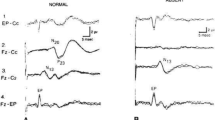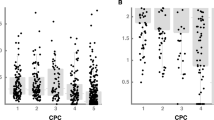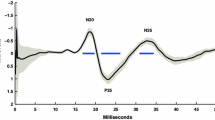Abstract
Background
Although median nerve somatosensory evoked potentials are routinely used for prognostication in comatose cardiac arrest survivors, myogenic artifact can reduce inter-rater reliability, leading to unreliable or inaccurate results. To minimize this risk, we determined the benefit of neuromuscular blockade agents in improving the inter-rater reliability and signal-to-noise ratio of SSEPs in the context of prognostication.
Methods
Thirty comatose survivors of cardiac arrest were enrolled in the study, following the request from an intensivist to complete an SSEP for prognostication. Right and left median nerve SSEPs were obtained from each patient, before and after administration of an NMB agent. Clinical histories and outcomes were retrospectively reviewed. The SSEP recordings before and after NMB were randomized and reviewed by five blinded raters, who assessed the latency and amplitude of cortical and noncortical potentials (vs. absence of response) as well as the diagnostic quality of cortical recordings. The inter-rater reliability of SSEP interpretation before and after NMB was compared via Fleiss’ κ score.
Results
Following NMB administration, Fleiss’ κ score for cortical SSEP interpretation significantly improved from 0.37 to 0.60, corresponding to greater agreement among raters. The raters were also less likely to report the cortical recordings as nondiagnostic following NMB (40.7% nondiagnostic SSEPs pre-NMB; 17% post-NMB). The SNR significantly improved following NMB, especially when the pre-NMB SNR was low (< 10 dB). Across the raters, there were three patients whose SSEP interpretation changed from bilaterally absent to bilaterally present after NMB was administered (potential false positives without NMB).
Conclusions
NMB significantly improves the inter-rater reliability and SNR of median SSEPs for prognostication among comatose cardiac arrest survivors. To ensure the most reliable prognostic information in comatose post-cardiac arrest survivors, pharmacologic paralysis should be consistently used before recording SSEPs.




Similar content being viewed by others
Abbreviations
- CPC:
-
Cerebral performance category score
- ICC:
-
Intraclass correlation coefficient
- NMB:
-
Neuromuscular blockade
- RMS:
-
Root mean square
- SNR:
-
Signal-to-noise ratio
- SSEP:
-
Somatosensory evoked potential
- TH:
-
Therapeutic hypothermia
References
Rothstein TL, Thomas EM, Sumi SM. Predicting outcome in hypoxic-ischemic coma. A prospective clinical and electrophysiologic study. Electroencephalogr Clin Neurophysiol. 1991;79:101–7.
Rothstein TL. SSEP retains its value as predictor of poor outcome following cardiac arrest in the era of therapeutic hypothermia. Crit Care. 2019;23:327.
Wijdicks EF, Hijdra A, Young GB, Bassetti CL, Wiebe S. Practice parameter: prediction of outcome in comatose survivors after cardiopulmonary resuscitation (an evidence-based review): report of the Quality Standards Subcommittee of the American Academy of Neurology. Neurology. 2006;67:203–10.
Callaway CW, Donnino MW, Fink EL, et al. Part 8: Post-Cardiac Arrest Care: 2015 American heart association guidelines update for cardiopulmonary resuscitation and emergency cardiovascular care. Circulation. 2015;132:S465–82.
Sandroni C, Cariou A, Cavallaro F, et al. Prognostication in comatose survivors of cardiac arrest: an advisory statement from the European Resuscitation Council and the European Society of Intensive Care Medicine. Intensive Care Med. 2014;40:1816–31.
Zandbergen EG, de Haan RJ, Stoutenbeek CP, Koelman JH, Hijdra A. Systematic review of early prediction of poor outcome in anoxic-ischaemic coma. Lancet. 1998;352:1808–12.
Zandbergen EG, Hijdra A, Koelman JH, et al. Prediction of poor outcome within the first 3 days of postanoxic coma. Neurology. 2006;66:62–8.
Amorim E, Ghassemi MM, Lee JW, et al. Estimating the false positive rate of absent somatosensory evoked potentials in cardiac arrest prognostication. Crit Care Med. 2018;46:e1213–21.
Howell K, Grill E, Klein A-M, Straube A, Bender A. Rehabilitation outcome of anoxic-ischaemic encephalopathy survivors with prolonged disorders of consciousness. Resuscitation. 2013;84:1409–15.
Pfeifer R, Weitzel S, Günther A, et al. Investigation of the inter-observer variability effect on the prognostic value of somatosensory evoked potentials of the median nerve (SSEP) in cardiac arrest survivors using an SSEP classification. Resuscitation. 2013;84:1375–81.
Zandbergen EG, Hijdra A, de Haan RJ, et al. Interobserver variation in the interpretation of SSEPs in anoxic-ischaemic coma. Clin Neurophysiol. 2006;117:1529–35.
Bouwes A, Binnekade JM, Kuiper MA, et al. Prognosis of coma after therapeutic hypothermia: a prospective cohort study. Ann Neurol. 2012;71:206–12.
van Soest TM, van Rootselaar A-F, Admiraal MM, Potters WV, Koelman JHMT, Horn J. SSEP amplitudes add information for prognostication in postanoxic coma. Resuscitation. 2021;163:172–5.
Hakimi K, Kinney G, Kraft G, Micklesen P, Robinson L. Reliability in interpretation of median somatosensory evoked potentials in the setting of coma: Factors and implications. Neurocrit Care. 2009;11:353.
Kane N, Oware A. Somatosensory evoked potentials aid prediction after hypoxic-ischaemic brain injury. Pract Neurol. 2015;15:352–60.
Fugate JE. Anoxic-ischemic brain injury. Neurol Clin. 2017;35:601–11.
Kim SW, Oh JS, Park J, et al. Short-latency positive peak following N20 somatosensory evoked potential is superior to N20 in predicting neurologic outcome after out-of-hospital cardiac arrest. Crit Care Med 2018;46.
Oh SH, Park KN, Choi SP, et al. Beyond dichotomy: patterns and amplitudes of SSEPs and neurological outcomes after cardiac arrest. Crit Care. 2019;23:224.
Endisch C, Storm C, Ploner CJ, Leithner C. Amplitudes of SSEP and outcome in cardiac arrest survivors. Neurology. 2015;85:1752.
Oh SH, Oh JS, Jung HH, et al. Prognostic value of P25/30 cortical somatosensory evoked potential amplitude after cardiac arrest. Crit Care Med. 2020;48:1304–11.
Logi F, Fischer C, Murri L, Mauguière F. The prognostic value of evoked responses from primary somatosensory and auditory cortex in comatose patients. Clin Neurophysiol. 2003;114:1615–27.
Scarpino M, Lolli F, Lanzo G, et al. SSEP amplitude accurately predicts both good and poor neurological outcome early after cardiac arrest; a post-hoc analysis of the ProNeCA multicentre study. Resuscitation. 2021;163:162–71.
Koo TK, Li MY. A guideline of selecting and reporting intraclass correlation coefficients for reliability research. J Chiropr Med. 2016;15:155–63.
Grossestreuer AV, Abella BS, Sheak KR, et al. Inter-rater reliability of post-arrest cerebral performance category (CPC) scores. Resuscitation. 2016;109:21–4.
Ajam K, Gold LS, Beck SS, Damon S, Phelps R, Rea TD. Reliability of the Cerebral Performance Category to classify neurological status among survivors of ventricular fibrillation arrest: a cohort study. Scand J Trauma Resusc Emerg Med. 2011;19:38.
Clapcich AJ, Emerson RG, Roye DPJ, et al. The Effects of propofol, small-dose isoflurane, and nitrous oxide on cortical somatosensory evoked potential and bispectral index monitoring in adolescents undergoing spinal fusion. Anesth Analg. 2004;99:1334–40.
Boisseau N, Madany M, Staccini P, et al. Comparison of the effects of sevoflurane and propofol on cortical somatosensory evoked potentials. Br J Anaesth. 2002;88:785–9.
Langeron O, Vivien B, Paqueron X, et al. Effects of propofol, propofol-nitrous oxide and midazolam on cortical somatosensory evoked potentials during sufentanil anaesthesia for major spinal surgery. Br J Anaesth. 1999;82:340–5.
Scheepstra GL, De Lange JJ, Booij LHDJ, Ros HH. Median nerve evoked potentials during propofol anaesthesia. Br J Anaesth. 1989;62:92–4.
Taniguchi M, Nadstawek J, Pechstein U, Schramm J. Total intravenous anesthesia for improvement of intraoperative monitoring of somatosensory evoked potentials during aneurysm surgery. Neurosurgery. 1992;31:891–7.
Schubert A, Licina Michael G, Lineberry PJ. The effect of ketamine on human somatosensory evoked potentials and its modification by nitrous oxide. Anesthesiology. 1990;72:33–9.
Kalkman CJ, Leyssius AT, Bovill JG. Influence of high-dose opioid anesthesia on posterior tibial nerve somatosensory cortical evoked potentials: effects of fentanyl, sufentanil, and alfentanil. J Cardiothorac Anesth. 1988;2:758–64.
Tobias JD, Goble TJ, Bates G, Anderson JT, Hoernschemeyer DG. Effects of dexmedetomidine on intraoperative motor and somatosensory evoked potential monitoring during spinal surgery in adolescents. Paediatr Anaesth. 2008;18:1082–8.
Acknowledgements
We would like to thank Jay Mandrekar, PhD, and Ross Dierkhising, MS, for their expertise and assistance with statistics.
Funding
None to declare.
Author information
Authors and Affiliations
Contributions
Conceptualization: all authors. Methodology: T.O., J.D.T., E.M.H. Formal analysis and investigation: T.O., J.D.T., E.M.H. Programming and data analysis: T.O. Statistical analysis: T.O., E.M.H. Original draft preparation: T.O., J.D.T., E.M.H. Review and editing: T.O., J.D.T., R.S.L., S.E.H., S.E.B., E.M.H.
Corresponding author
Ethics declarations
Conflict of interest
All authors have no conflicts of interest to disclose.
Ethical Approval
Our study adheres to ethical guidelines as specified by the institutional review board.
Additional information
Publisher's Note
Springer Nature remains neutral with regard to jurisdictional claims in published maps and institutional affiliations.
Supplementary Information
Below is the link to the electronic supplementary material.
12028_2022_1601_MOESM2_ESM.tif
Rate of agreement between the five raters and the formal interpretation by the neurophysiologist, when the official interpretation was (A) present and (B) absent N20 cortical response. Because all formal interpretations by the neurophysiologist were deemed diagnostic, the raters’ response on the presence or absence of cortical potential was used for comparison (irrespective of their rating on diagnostic quality). Abbreviations: NMB = neuromuscular blockade. SSEP = somatosensory evoked potential. (TIF 361 kb)
Rights and permissions
Springer Nature or its licensor holds exclusive rights to this article under a publishing agreement with the author(s) or other rightsholder(s); author self-archiving of the accepted manuscript version of this article is solely governed by the terms of such publishing agreement and applicable law.
About this article
Cite this article
Oishi, T., Triplett, J.D., Laughlin, R.S. et al. Short-Acting Neuromuscular Blockade Improves Inter-rater Reliability of Median Somatosensory Evoked Potentials in Post-cardiac arrest Prognostication. Neurocrit Care 38, 600–611 (2023). https://doi.org/10.1007/s12028-022-01601-4
Received:
Accepted:
Published:
Issue Date:
DOI: https://doi.org/10.1007/s12028-022-01601-4




